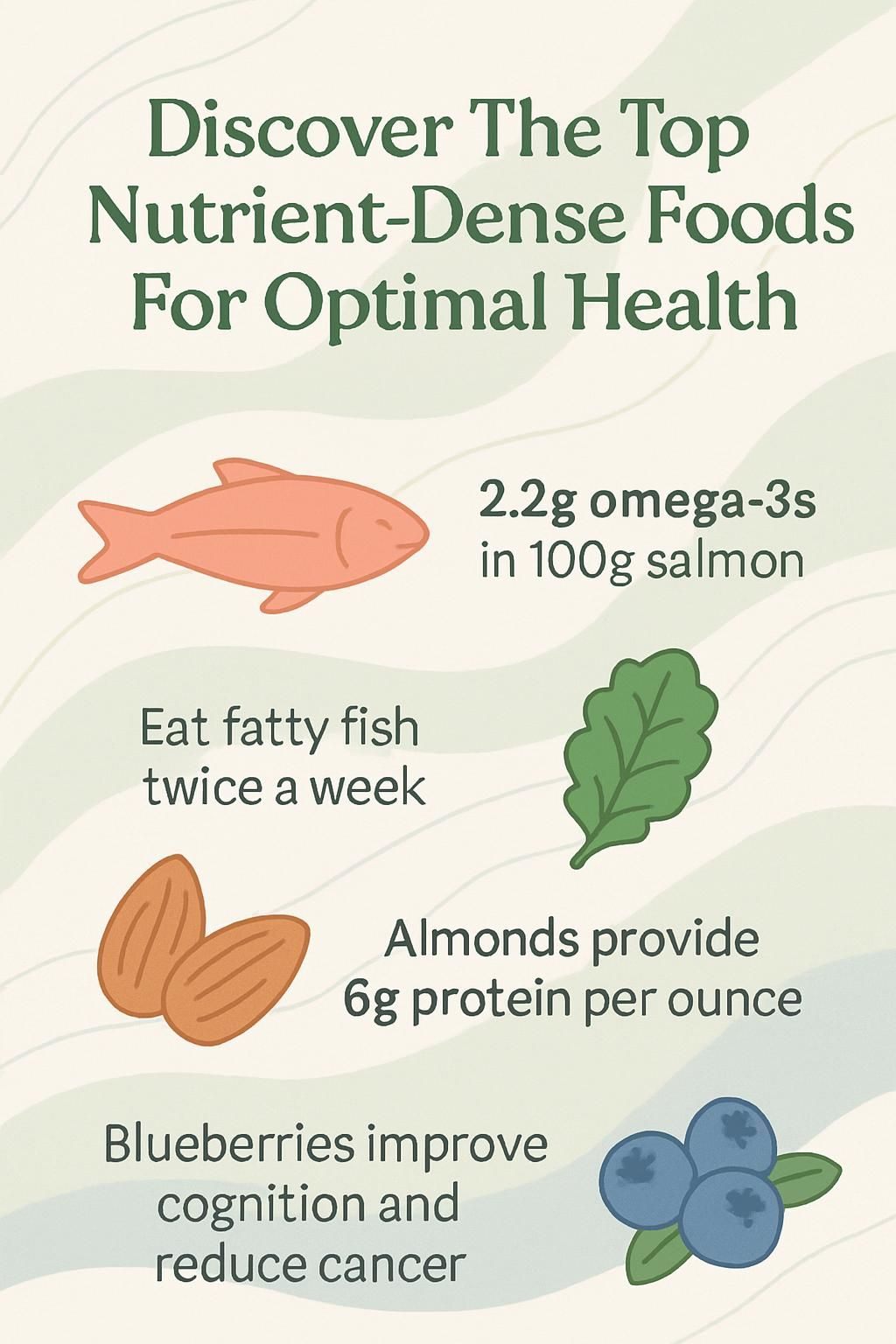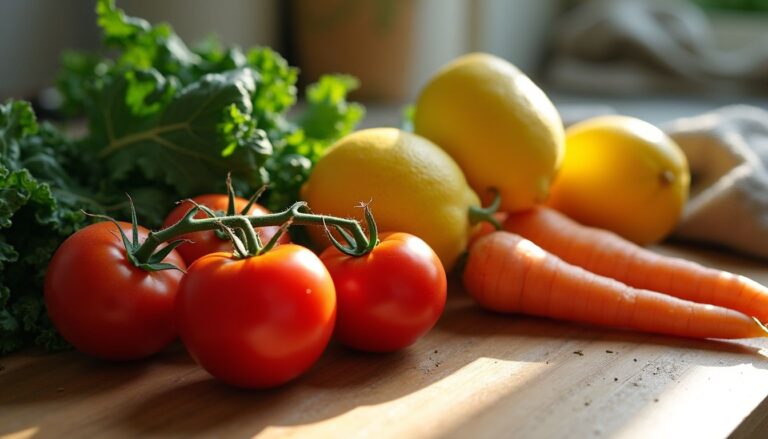Discover The Top Nutrient-Dense Foods For Optimal Health
Our Nutrition Assistant AI Suite will transform your body. You will lose fat, get toned, and build muscle. Gain confidence and optimal health.
You might eat healthy foods yet still feel run down. Adding more nutrient-dense food, which packs many vitamins and minerals into fewer calories, can help you feel stronger each day.
This guide shows you which choices deliver the most nutrition for every bite. Learn simple swaps that boost energy, focus, and long-term health without a complicated plan.
Key Takeaways
- Nutrient-dense foods, including salmon at 2.2 grams of omega-3s per 100 grams, leafy greens, berries, and nuts, deliver many vitamins, minerals, protein, and healthy fats with relatively few calories.
- Eating fatty fish like salmon or sardines twice each week is linked with lower heart disease risk, according to the American Heart Association’s 2020 guidance.
- Leafy greens such as kale at 9 calories per cup, spinach, and collards supply vitamin K, iron, and fiber that support bones and immune function with minimal calories.
- Berries contain antioxidants like anthocyanins. Research by Kalt W and colleagues in 2020 connects routine blueberry intake with better thinking skills and a lower risk of cancer growth.
- Nuts and seeds, for example almonds with 6 grams of protein per ounce, can improve blood sugar control and provide magnesium, calcium, fiber, and vitamin E for steady energy.

What Are Nutrient-Dense Foods?

Nutrient-dense foods give you a high level of vitamins and minerals for each calorie. Choosing them helps you meet daily needs and build a healthy diet.
What does nutrient-dense food mean and why is it important?
Nutrient-dense foods deliver many vitamins, minerals, protein, and healthy fats without excess calories. Leafy greens like kale and spinach are strong examples. They provide vitamin K, iron, lutein, and fiber with very few calories.
Salmon provides omega-3 fats, B vitamins, selenium, and quality protein while keeping calories in check. The 2020 to 2025 Dietary Guidelines for Americans encourage eating these foods often to support health.
Picking foods rich in nutrients supports digestion, energy production, and immune function. Whole grains such as quinoa and oatmeal add fiber and magnesium that aid heart health. Highly processed items are usually high in added sugar or saturated fat and low in vital nutrients. They can raise inflammation over time.
A single food cannot supply every nutrient; variety across food groups matters.
Rotating plant sources of calcium such as broccoli and beans may help improve cholesterol numbers and reduce the risk of chronic conditions, according to recent studies.
Which key nutrients should I look for in foods?
Focus on vitamins A, C, E, K, and the B family, which includes B6, B12, folate, and niacin. These support your skin, bones, and metabolism. Aim for minerals like potassium, magnesium, calcium, iron, zinc, copper, manganese, selenium, and phosphorus for blood and nerve health. Leafy greens are a reliable source of vitamin K and iron.
Include complete protein to maintain muscles. Eggs deliver all essential amino acids. Legumes such as lentils and chickpeas give plant-based protein plus fiber. Choose omega-3 fats from oily fish like salmon and sardines to support heart health.
Nuts provide vitamin E and magnesium, and their fiber helps steady blood sugar. Dark chocolate supplies antioxidants called flavonoids that can benefit the heart when eaten in small amounts. Look for plant chemicals too, such as anthocyanins in berries and glucosinolates in broccoli and cabbage, which may help protect cells.
Benefits of Eating Nutrient-Dense Foods
These foods support many parts of your body and help you stay well over time. They pack vitamins, minerals, antioxidants, and fiber into modest calories.
How do nutrient-dense foods support overall health and wellness?
Nutrient-dense choices deliver antioxidants and phytochemicals, which are plant compounds that defend cells. Diets rich in leafy greens, berries, nuts, whole grains, and beans can lower inflammation and oxidative stress, two factors tied to disease risk.
Meals high in nutrients help regulate immunity and organ function. They keep you satisfied with fewer calories, so weight control becomes easier. Many people also report steadier energy through the day. I noticed better focus after shifting more of my plate to vegetables, whole grains, and fish.
Adding whole grains, nuts, seeds, and fatty fish supports heart health. Calcium-rich options like almonds and leafy greens aid bone and tooth strength.
The greatest wealth is health.
How can these foods promote heart health?
Fatty fish such as salmon offer about 2.2 grams of omega-3s per 100 grams. Omega-3 fats help maintain flexible blood vessels and support a healthy heart. Sardines are a smart pick for salads or pasta. They provide high omega-3s with lower mercury than many large fish.
Nuts and seeds add monounsaturated fats that can lower LDL, the harmful type of cholesterol. Garlic contains allicin, a compound linked to lower blood pressure and LDL. Dark chocolate with 70 to 85 percent cocoa may help maintain healthy blood pressure, based on American Heart Association commentary from 2019. Broccoli adds vitamin C and glucosinolates, plant chemicals that help protect blood vessels.
Following patterns common in the Mediterranean diet, such as eating more vegetables, whole grains like brown rice and quinoa, and canned salmon, gives your heart regular support.
In what ways do nutrient-dense foods boost immunity?
Shellfish like clams, oysters, scallops, and mussels supply zinc and selenium. Zinc supports the growth of infection-fighting cells. Selenium helps the body build proteins needed for immune function. Getting enough vitamin C from foods also supports your defenses.
Leafy greens provide vitamins A and C plus antioxidants that limit cell damage. Garlic adds allicin and vitamin C, B1, B6, and selenium, which support white blood cells. Blueberries deliver anthocyanins that shield cells from oxidative stress. Almonds offer vitamin E that helps maintain immune health over time.
Broccoli combines vitamin C with glucosinolates for added protection. Seaweed contains iodine, which supports the thyroid. A healthy thyroid helps keep your immune system on track.
Can nutrient-dense foods enhance energy levels?
Yes. Whole grains like quinoa and brown rice supply complex carbs and B vitamins. These support a steady release of energy, unlike sugary foods that cause spikes and crashes. Potatoes add potassium, magnesium, fiber, and B vitamins for energy metabolism.
Eggs provide choline and high-quality protein for muscles and lasting fuel. Beans and other legumes offer fiber, iron, thiamin, and protein. They support oxygen transport in the blood and cellular energy production. Apples provide soluble and insoluble fiber, which can stabilize blood sugar and energy.
After sports, chocolate milk can help refuel because its mix of carbs and protein rebuilds glycogen faster than water alone.
How do these foods improve mental clarity and focus?
Berries, especially blueberries, are rich in anthocyanins, a type of antioxidant. Studies link these compounds with sharper thinking, better mood, and healthy blood flow to the brain, including Kalt W and colleagues in 2020.
Egg yolks contain choline plus lutein and zeaxanthin, two carotenoids that support brain and eye health. Spinach and other leafy greens provide B vitamins and carotenoids; folate may help lower age-related cognitive decline.
Seaweed is rich in iodine, a mineral that supports thyroid function. Your thyroid affects memory and focus. Quinoa offers plant-based iron and B vitamins for nerve signaling. Some research suggests bitter melon could help protect memory in Alzheimer’s disease. These foods are low in calories yet packed with protective nutrients.
Top Nutrient-Dense Foods to Include in Your Diet
These choices bring flavor, variety, and a high return on nutrition. Use them to build meals that meet your goals without excess calories.
Fatty Fish
Fatty fish such as salmon and sardines provide omega-3 fats and quality protein with modest calories.
- Eat salmon, sardines, or tuna to boost EPA and DHA, the key omega-3 fats.
- People who include fatty fish in their healthy diet have lower risks of stroke and heart disease, based on American Heart Association reports.
- Pick fresh or water-packed canned fish to limit extra oil and reduce mercury exposure.
- Choose sustainable sources to support ocean health and lower contamination risks.
- Fatty fish makes a satisfying snack, supports brain function, and benefits joints.
- A 3-ounce serving supplies about 1 gram of omega-3s with relatively few calories.
- These fish deliver vitamin B12 and can help cover iron needs when paired with leafy greens or beans.
Salmon
One 100-gram serving of salmon provides 2.2 grams of omega-3s and about 25 grams of protein. It is rich in magnesium, potassium, selenium, and B vitamins that support the brain, heart, lungs, immunity, and hormones.
Salmon also supplies vitamin A. It pairs well with leafy greens and legumes to round out your plate. The American Heart Association suggests eating oily fish like salmon at least twice per week for heart protection. Choose sustainably sourced salmon when possible.
Sardines
Sardines are small but packed with nutrients. You can eat them whole, including the soft bones and skin, which adds calcium and collagen. Sardines deliver omega-3 fats with low mercury compared with many larger fish.
They provide calcium, vitamin D, B vitamins, selenium, and phosphorus. Add sardines to salads, whole grain toast, or pasta. The United States Department of Agriculture lists sardines among more sustainable seafood choices. Regular intake supports heart function and daily calcium needs.
Leafy Greens
Leafy greens offer many vitamins and minerals with very few calories. Eating a variety supports vision, immunity, and heart health.
- Kale, spinach, and collards deliver vitamins A, C, and K, plus folate and potassium.
- Rotate different leafy greens to cover more nutrients through the week.
- Leafy greens contain calcium for bones and fiber for digestion.
- Antioxidants in kale and spinach may lower inflammation and disease risk.
- These vegetables are low in calories and rich in helpful plant chemicals called phytonutrients.
- Beet greens and turnip greens add more minerals and flavors to your meals.
- Eat them raw or lightly cooked to preserve vitamin C and keep minerals available.
The next section highlights the advantages of adding cruciferous vegetables for even better balance.
Kale
Kale provides vitamins C, A, and K, plus B6, potassium, calcium, magnesium, copper, and manganese. One cup has only 9 calories and delivers fiber and protective plant compounds.
Research by Lui D and colleagues in 2023 shows kale and wild cabbage have strong antioxidant properties and may help slow harmful cell growth. Kale can also support cholesterol control. Enjoy it raw in salads or blended into smoothies to boost your daily intake.
Spinach
Spinach is rich in vitamins A and C, potassium, carotenoids, folate, magnesium, and iron. It supports immune function and red blood cell production. Lutein and zeaxanthin help protect your eyes from macular degeneration.
Eat spinach raw or lightly cooked in soups and omelets to keep more nutrients. Blend fresh spinach into a smoothie with berries for an easy breakfast upgrade.
Collard Greens
Collards belong to the cruciferous vegetable family and bring high nutrition with low calories. One cup of cooked collards supplies about 770 micrograms of vitamin K. They also provide calcium for bones and fiber for digestion.
Lightly steam or eat raw to keep the most vitamins. The antioxidants and phytonutrients in collards support cardiovascular and cell health. Use whole leaves as wraps or serve with sweet potatoes for a filling dinner.
These qualities put collards beside kale and spinach in nutritional value. They offer fresh variety among leafy greens.
Next up are other members of the cruciferous vegetables like broccoli that offer unique advantages for your diet.
Cruciferous Vegetables
Broccoli, cauliflower, cabbage, and Brussels sprouts pack helpful compounds in every serving.
- Broccoli adds fiber, vitamin C, potassium, and glucosinolates that help protect cells.
- Cauliflower supports cell repair and heart health while staying low in calories.
- Cabbage provides vitamins and phytonutrients that may reduce chronic disease risk.
- Brussels sprouts carry antioxidants that aid blood vessel health.
- Eating these vegetables often can help with fullness and support weight control.
- Experts such as Alex Nella at UC Davis advise eating them raw or quickly steamed to keep nutrients.
- Adding broccoli or cabbage to lunch can improve immunity and steady afternoon energy.
Next, learn how berries can support your goals with nutrient density and unique plant compounds.
Broccoli
Broccoli stands out for fiber, antioxidants, and vitamins like vitamin C and lutein. It also contains glucosinolates, plant chemicals that support natural detoxification. Research in 2020 discussed the value of these compounds for metabolism and cell protection.
Eat broccoli raw or lightly cooked to retain more nutrients. Vitamin C helps your body absorb iron from beans and whole grains. Lutein supports your eyes. Regular intake may aid heart function and blood sugar control.
Cauliflower
Cauliflower offers about 77 percent of your daily vitamin C in one cup of raw florets. It provides fiber for digestion and satiety with only about 25 calories per cup. Glucosinolates and other phytonutrients support natural detox processes.
Enjoy it raw with hummus, roasted for flavor, or steamed to keep nutrients. Use cauliflower rice or crust to raise veggie intake without many carbs.
Cabbage
Cabbage supplies vitamin C, vitamin K, and fiber while keeping calories low. It contains glucosinolates that may help prevent some cancers and support a healthy inflammatory response.
Eat cabbage raw in slaw or cooked in stir-fries and soups. This affordable vegetable adds crunch and fullness that supports digestion and heart health.
Now let’s explore why berries rank among the top nutrient-dense foods.
Berries
Berries give you big nutrition in a small package. They taste sweet, have few calories, and offer many antioxidants.
- Choose blueberries, strawberries, and raspberries to increase antioxidants and support immunity.
- Three fourths of a cup of blueberries provides 2.7 grams of fiber and 10.8 milligrams of vitamin C.
- Anthocyanins in berries can improve mood and thinking while fighting oxidative stress.
- Studies, including Kalt W and colleagues in 2020, link berries with slower cancer growth.
- Berries deliver vitamins, fiber, and plant compounds that support healthy aging.
- Enjoy them fresh or add to oatmeal and smoothies for a quick boost.
- Their low calories make them easy to include often.
You can explore other nutrient-dense foods like nuts and seeds next for more benefits.
Blueberries
Blueberries contain many anthocyanins. A 3/4 cup serving offers 2.7 grams of fiber and 10.8 milligrams of vitamin C with few calories.
Studies such as Travica N and colleagues in 2020 suggest blueberries may improve cognitive function and mood. Woolf EK and colleagues in 2023 found support for better blood vessel function. Research by Zhao F and colleagues in 2023 suggests blueberries may help inhibit cancer cell growth.
Adding fresh blueberries to oatmeal is a simple breakfast habit that increases your intake of raw, nutrient-rich foods.
Strawberries
Strawberries provide over 100 percent of your daily vitamin C in one cup with about 50 calories. Their phytonutrients can reduce inflammation and support blood flow, which benefits the heart.
Eat them fresh, toss into salads, or add to yogurt. The high water content helps with hydration while fiber supports digestion.
Raspberries
Raspberries are rich in fiber, vitamin C, and anthocyanins. One cup delivers 8 grams of fiber, which helps digestion and blood sugar control, with only about 64 calories.
They also contain ellagitannins, plant compounds linked to anticancer effects. Add raspberries fresh or frozen to bowls, yogurt, or oatmeal for instant color and nutrition.
Summary:
- High in fiber at 8 grams per cup
- Excellent source of vitamin C
- Contain anthocyanins and ellagitannins
- Support digestion, blood sugar, and lower inflammation
- Low calorie yet nutrient packed
- Versatile, use fresh or frozen
Nuts and Seeds
Nuts and seeds deliver healthy fats, protein, fiber, and key minerals. They are easy add-ins for meals and snacks.
- Almonds provide magnesium, calcium, and zinc. Choose unsalted, natural almonds to limit sodium.
- Chia seeds are very high in fiber. Stir into cereals or smoothies to support digestion and fullness.
- Flaxseeds supply plant-based omega-3s. Use ground flax for better absorption in oatmeal or baking.
- These foods are rich in plant protein that keeps you full and supports muscle repair.
- Vitamin E in almonds acts as an antioxidant to protect cells.
- Nuts and seeds support weight control because they improve satiety after meals.
- Mix chia into yogurt for a quick breakfast that sustains energy longer than sugary cereal.
- Calcium and magnesium in nuts and seeds support bone development.
- Choose raw or natural varieties rather than roasted with added oils or salt.
- Add to salads, cereals, trail mixes, or muffins for crunch and nutrition.
These simple choices help your heart, brain, and bones while improving daily nutrient intake.
Almonds
Almonds deliver vitamin E, magnesium, calcium, and folate in a convenient snack. One serving covers a large share of daily vitamin E, notes Jeffrey Caspar at UC Davis. Vitamin E supports eye health and defends cells from damage.
Almonds also provide protein, fiber, and heart-friendly monounsaturated fats. Eating unsalted, natural almonds brings the best value. Their fiber helps steady blood sugar, and antioxidants protect cells.
Nutritional content per 1 ounce, about 23 almonds:
- Calories: 164
- Protein: 6 grams
- Fiber: 3.5 grams
- Vitamin E: about 37 percent of daily needs
- Magnesium: roughly 19 percent of daily value
Keep a small container on your counter or in your bag for an easy, nutrient-dense snack.
Chia Seeds
Chia seeds supply about 4 grams of fiber per tablespoon. Fiber supports digestion and may help reduce cholesterol. These tiny seeds contain omega-3 fats that support heart health, plus protein and minerals like calcium, magnesium, and phosphorus.
Chia seeds absorb water and form a gel, which helps with hydration during sports or busy days. They may also help steady blood sugar after meals. Add to smoothies, yogurt, or overnight oats for a satisfying texture and long-lasting energy.
Flaxseeds
Flaxseeds are high in alpha-linolenic acid, a plant-based omega-3 that supports heart health. Each tablespoon has about 2 grams of ALA and 3 grams of fiber, along with protein, magnesium, phosphorus, B vitamins, and lignans, which are antioxidants.
Choose ground flaxseeds for better absorption. Sprinkle into smoothies, oatmeal, or pancake batter. Regular flax intake is linked with lower cholesterol and improved digestion.
Whole Grains
Whole grains such as quinoa, oatmeal, and brown rice deliver fiber, B vitamins, and minerals. They help digestion and provide steady energy for school, work, or training.
- Pick whole grains like quinoa, brown rice, and oatmeal to increase fiber for regularity.
- Eat oats for beta-glucan, a fiber shown to lower cholesterol and aid heart health.
- Choose brown rice for magnesium. One cup supplies about 11 percent of daily needs.
- Add wheat germ to cereal or fruit bowls for B vitamins and vitamin E.
- Swap refined grains for whole grains to raise selenium and other minerals for immunity.
- Try quinoa as a higher protein grain with a low glycemic index to steady blood sugar.
- Use oatmeal or brown rice as a base for sweet or savory meals.
Quinoa
One cooked cup of quinoa provides about 8 grams of protein and 5 grams of fiber. It is gluten free and supplies B vitamins that help your body turn food into energy.
Quinoa has a low glycemic index, which helps balance blood sugar. It also delivers magnesium, phosphorus, and manganese for bone strength, heart function, and energy metabolism. Simmer for about 15 minutes and use as a base for bowls or salads.
Oatmeal
Oatmeal is rich in beta-glucan fiber that supports healthy cholesterol levels and heart health. It also provides B vitamins, magnesium, and iron for energy and red blood cell function. Whole oats have more nutrients than many instant types.
Oatmeal keeps you full through the morning because of its fiber. Top with fruit, nuts, or chia seeds to raise the nutrient density. The American Heart Association reports that diets rich in whole grains like oats can support heart health over time.
Brown Rice
Brown rice offers fiber, magnesium, and selenium. One cup has about 3.5 grams of fiber and supplies B vitamins plus complex carbs for steady energy.
Choosing brown rice in place of white rice is linked with a lower risk of type 2 diabetes. Use it in stir-fries, grain bowls, or with lean proteins and vegetables. Its mild taste fits many recipes.
Other Superfoods
These foods stand out for helpful nutrients and strong research support. Adding them can lift your vitamin, mineral, and antioxidant intake.
- Garlic boosts flavor and provides allicin, which may lower blood pressure and cholesterol.
- Dark chocolate at 70 percent cocoa or higher contains flavonoids, antioxidants that can support brain function and reduce inflammation when eaten in small amounts.
- Avocados supply monounsaturated fats, potassium, fiber, and vitamins E and C. Eating them several times per week is linked to lower heart disease risk.
- Seaweed adds iodine, calcium, magnesium, iron, and antioxidants to support thyroid and immune health.
- Sweet potatoes provide beta-carotene, which converts to vitamin A, plus fiber and vitamin C.
- Green tea contains catechins, a type of antioxidant. Daily intake is associated with lower LDL cholesterol and improved metabolism.
You can explore strategies for maximizing nutrient intake to further strengthen your diet quality.
Garlic
Garlic provides vitamin C, vitamin B1, and B6 along with calcium and potassium. Its active compound, allicin, has been linked to reductions in blood pressure and LDL cholesterol, which supports heart health. Adding garlic to kale salads, roasted vegetables, and beans raises flavor and nutrition.
Studies suggest regular garlic intake may raise HDL, the helpful cholesterol, while lowering LDL. It may also help reduce inflammation and protect against some cancers.
Nutritional highlights per 3 cloves
| Nutrient | Amount |
|---|---|
| Vitamin C | 2 mg |
| Vitamin B6 | 0.11 mg |
| Calcium | 16 mg |
| Potassium | 36 mg |
References: [1] National Library of Medicine, Effect of Garlic on Blood Pressure, 2024.
Dark Chocolate
Dark chocolate with 70 to 85 percent cocoa provides iron, magnesium, copper, manganese, and fiber plus antioxidants. Evidence links small portions with healthier blood pressure and cholesterol numbers, although findings vary.
Enjoy dark chocolate in moderation. Pair with almonds or blueberries for a more balanced snack.
Avocados
Avocados offer monounsaturated fats that can lower LDL cholesterol and raise HDL. They also provide potassium, vitamin E, folate, and about 10 grams of fiber per medium fruit. These nutrients support heart health, brain function, and digestion.
Add sliced avocado to salads, tacos, eggs, or whole-grain toast to build a satisfying, nutrient-dense meal.
Tips for Maximizing Nutrient Intake
Small, steady changes add up. Use these ideas to get more from every meal.
How can I incorporate variety into my meals?
Plan each meal with different food groups. Include fruits, vegetables, whole grains, legumes, nuts, and seeds. Snack on almonds or spread peanut butter on apple slices for a quick protein and fiber boost.
Rotate leafy greens. Try kale in salads one day, then switch to spinach or collards the next. Add colorful vegetables like beets and sweet potatoes for extra nutrients.
Swap refined grains for whole grains such as quinoa, brown rice, and oatmeal. Use a mix of raw and lightly cooked vegetables to preserve vitamins. Blend berries into yogurt or smoothies for variety through the week. If you have unique needs, speak with a registered dietitian for personal advice.
Why choose fresh and minimally processed foods?
Fresh and minimally processed options usually contain more vitamins, minerals, and antioxidants than heavily processed choices. Diets that emphasize these foods are linked with lower risk for type 2 diabetes, heart disease, and some cancers.
Whole grains, legumes, nuts, and seeds keep their fiber, which supports digestion and heart health. Seasonal produce brings color and flavor while maximizing nutrients.
What are the benefits of opting for seasonal fruits and vegetables?
Seasonal produce is harvested at peak ripeness, which often means better taste and higher nutrient levels. For example, strawberries picked in June tend to hold more vitamin C than fruit stored long term.
Buying seasonal foods supports local farms and often costs less. It also adds variety across the year, giving you a wider range of nutrients. I grew up visiting farm stands each summer, and the taste of just-picked corn and tomatoes made eating vegetables far easier for my family.
Seasonal choices support sustainability with shorter transport, less packaging, and fewer preservatives.
How do I cook foods to preserve their nutrients?
Steam or bake vegetables to keep more vitamins and minerals. Quick steaming for 5 to 10 minutes works well for broccoli, cauliflower, and cabbage. Eating some greens raw or adding them near the end of cooking helps protect heat-sensitive nutrients like vitamin C and folate.
Cook leafy greens briefly to maintain vitamin K, folate, and magnesium. Choose whole grains more often than refined grains since they retain fiber and B vitamins. Avoid long cooking times and heavy processing to preserve antioxidants.
Conclusion
Filling your plate with nutrient-dense foods supports a healthy diet and steady energy. Salmon, kale, berries, nuts, dark chocolate, and whole grains supply vitamins, minerals, protein, healthy fats, and fiber backed by respected sources such as Healthline and UC Davis Health. You can lower disease risk and feel sharper when you build meals around these choices.
Pick a few foods from this list and use them this week. Small upgrades, like swapping in whole grains or adding a leafy green salad, can make a clear difference. This article is for general education. For personal guidance, consult your clinician or a registered dietitian.
^1: “The 11 Most Nutrient-Dense Foods on the Planet,” Healthline
^2: “Eat This Not That: The Science Behind Good Nutrition,” UC Davis Health
FAQs
1. What are nutrient-dense foods and why do they matter for optimal health?
Nutrient-dense foods provide high levels of vitamins, minerals, and other essential nutrients with fewer calories. These foods support strong immune function, healthy growth, and disease prevention. Research shows that diets rich in leafy greens, berries, seafood like salmon or sardines, eggs, beans, nuts such as almonds or walnuts, and whole grains can improve overall well-being.
2. Which top nutrient-rich foods should I include in my daily meals?
Leafy vegetables such as spinach and kale offer iron and vitamin K; berries supply antioxidants; fatty fish deliver omega-3 fats; legumes give protein and fiber; nuts contain magnesium; seeds add zinc; dairy products like yogurt provide calcium. A 2020 study found people who ate a variety of these items had lower risks for chronic illness.
3. How can I use data to choose the best nutrient-packed options?
Review nutrition labels for values like protein content per serving or percent daily value of key vitamins. For example: One cup of cooked spinach contains about 245 mg potassium (7% DV) while three ounces of wild-caught salmon supplies over 1000 mg omega-3s (more than 200% recommended intake). Tables comparing food groups help identify which choices meet your needs.
4. Can you share a personal way to add more nutrient-dense foods into everyday life?
I started adding chopped kale to morning omelets after reading studies on its benefits for heart health. This simple change increased my vegetable intake without much effort or cost. Small steps such as swapping white bread for whole grain toast or snacking on mixed nuts instead of chips make it easier to maintain balanced eating habits.
Summary: Nutrient-rich choices like leafy greens, colorful fruits, oily fish, beans, nuts, seeds, dairy products from cows or goats contribute vital elements needed by the body each day according to recent evidence-based research findings.







